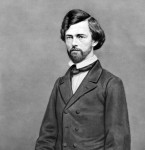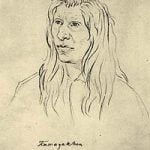
It will be recalled that Governor Stevens of Washington Territory had been marooned to the northeast by the war. Fort Bennett received him late in the day on December 20, 1855. He had exhibited a rare insight into Indian character in his masterly conduct of treaty negotiations.
Governor Stevens had left Walla Walla in June, 1855, with an escort of Nez Perce and had spent some time in establishing a spirit of cooperation with the Kootenai, Pend d’Oreilles, and Flathead tribes before visiting the Blackfeet. In October, having concluded a treaty with the latter tribe, he prepared to return home. His messenger, W. H. Pearson, had carried the news of the treaty to Olympia and then immediately retraced his steps to report to the Governor that the Yakima War was in full swing and that it would be impossible for him to traverse the hostile country. In fact, Pearson brought a recommendation from regular army officers that Stevens return to Olympia via New York!
The Governor, meanwhile, had actually started for the Columbia River and was two days on his way when met by Pearson. Stevens delayed long enough to send back to Fort Bennett for additional arms, ammunition, and horses, and then, with one white man and an Indian interpreter, rode post-haste to the Bitterroot Valley to confer with R. H. Landsdale, agent in charge of the Flatheads there. He then proceeded to Fort Owen, on the Bitterroot River where he overtook the Nez Perce escort which, in the meantime, had learned of the Yakima War and that the Cayuses and a disaffected faction of their own tribe were likely to join with the warring tribes. In the delegation were three of their war chiefs, Lookingglass, Three Feathers, and Spotted Eagle. It is a compliment to Stevens’ ability that he not only persuaded them to stay out of the war but that he received from them an offer of an escort of young Nez Perce warriors to see him safely through to The Dalles should he elect to take the route through the Nez Perce country.
At Hell Gate Pass he was met by Special Agent James Doty with the horses and munitions from Fort Bennett, on November 11th. On the 20th he crossed the Bitter Root Mountains through three feet of snow. His plan called for a bold entry into the country of the Coeur d’Alenes not knowing how that tribe might be disposed toward the hostiles allied in the Yakima War. When about two hours ride from the Coeur d’Alene Mission he left his escort and rode ahead with Pearson, Special Agent William Craig and four Nez Perce. Without slackening their pace they rode into the midst of the Coeur d’Alenes, but were prepared for any emergency which might ensue. Stevens had told the four Nez Perce to immediately regale the Coeur d’Alenes with an ac-count of his treaty with the Blackfeet stressing the importance of that treaty to the Coeur d’Alenes in having halted the raids which the Blackfeet had periodically made. Stevens’ phychology was good. The Coeur d’Alenes were pleased with the prospect. Before there was any time for the tribe to reconsider, Stevens’ escort and supply train arrived and the entourage set out at once for the country of the Spokane. The event had transpired so quickly that the Coeur d’Alenes had no time to compare what Stevens had to offer through the Blackfeet treaty and that which Kamiakin’s ambassadors had told them a week earlier.
The Governor next stopped at the home of Antoine Plante, a French-Canadian settler who lived midway between the country of the Coeur d’Alenes and that of the Northern Spokane. He sent messengers to the Colville, the Pend Oreille, and the Spokane to meet him at Plante’s place. Also invited were Angus McDonald of Fort Colville, Father Ravelli of the Colville Mission, and Father Joset of the Coeur d’Alene Mission.
In a few days all had assembled and a council was held. At the end of several days it looked as if the whole matter would end without affirmative result because the Indians held out for a guarantee that United States troops would not cross to the north side of the Snake River. Of course Stevens had no authority to make that promise and did not. Eventually he won the Indians over to his opinions after which the Spokane warned him that the Nez Perce chief, Lookingglass, was up to some treachery, which fact Stevens confirmed by his Indian interpreter, who was a Delaware, and who had heard Lookingglass attempting to persuade the Spokane to join in his treachery, which probably meant the liquidation of Stevens and his associates. The Spokane refused to join in the Lookingglass plot and Stevens prepared to move towards Lapwai.

He sent William Craig and some of the Nez Perce ahead to arrange for a council and to make arrangements for an escort to The Dalles. The Governor, himself, enlarged his party by adding a group of miners and others who were waiting for a chance to get through the hostile country. His personal escort then numbered fifty men. Not knowing what dangers he might encounter, he procured fresh horses from the Spokane, reduced the packs to a minimum, and set out. It rained and snowed, but Stevens pressed on and in four days reached Lapwai. Craig had assembled the Nez Perce tribe for the council. While it was in progress a messenger arrived with the news of the battle between the Oregon volunteers and the Yakima and also about the death of Peu-peu-mox-mox. Two points were thus made clear. Stevens now understood that it had been possible for him to come through hostile country only because the warriors were away at the scene of the fighting and he also knew that a large escort to The Dalles would not be needed. So the next day he set out with 69 Nez Perce and the others o his party and reached Fort Bennett on December 20th.
He staid in the Walla Walla Valley for ten days during which he paid tribute to the Oregon volunteers, as their presence in the region was undoubtedly responsible for his escape. He also met Indian Agent B. F. Shaw, who was also a Colonel in the militia of Washington Territory. He ordered Shaw to form a company of home guards and to prepare fortifications adjacent to the winter quarters of the French-Canadian settlers and friendly Indians in the Walla Walla Valley. His instructions to Shaw also included similar protection for the settlers in the Colville and Spokane districts and the admonition to assist Colonel Thomas R. Cornelius, the new commander of Oregon volunteers, in any way the latter might direct. The Governor also conferred with the Oregon officers and agreed that it would be well for them to hold the Walla Walla Valley until the regular troops arrived and in the meantime that there should be no relaxing of the war effort. He sent Craig to Lapwai with the 69 Nez Perce to muster them out of service and to see that the muster rolls were prepared in such a manner that there would be no doubt about payment to the Nez Perce for their services. Craig’s duties also entailed taking measures for the protection of the Nez Perce tribe against raids by hostiles. These measures included the use of young Nez Perce braves as patrols and guards for which service they would be paid. The tribe was pleased at the interest shown in their welfare and as a token of appreciation offered to outfit the Oregon volunteers with fresh horses.
Governor Stevens then returned to Olympia where he received a rousing welcome, not only for his achievements and safe return, but because Indian troubles had broken out in the Puget Sound district nearby and his presence at home was important.
